Key takeaways:
- Modern cameras boast advanced autofocus systems, enabling quick and precise focusing on moving subjects, enhancing the overall shooting experience.
- Sensor technology significantly improves image quality, dynamic range, and low-light performance, allowing for clearer and more vibrant photographs in various conditions.
- Interchangeable lenses offer versatile creative possibilities, enabling photographers to adapt to different environments and capture unique perspectives.
- Creative modes, such as double exposure and time-lapse, encourage artistic expression and enable photographers to tell engaging visual stories.
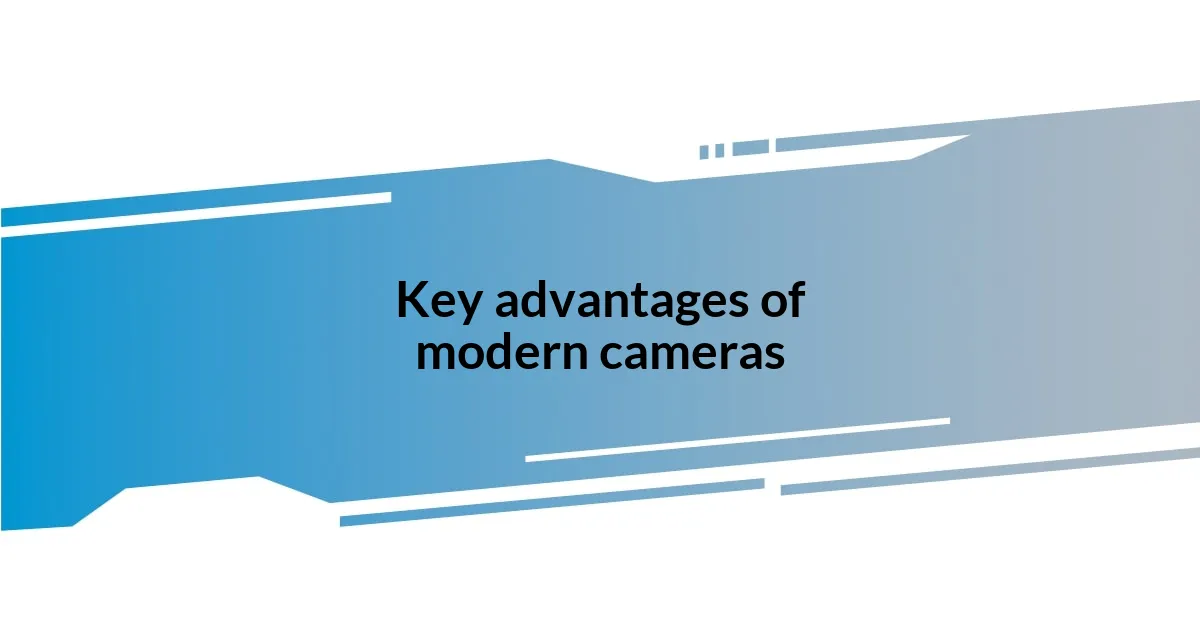
Key advantages of modern cameras
One of the standout advantages of modern cameras is their incredible autofocus systems. I remember the first time I shot a fast-moving subject, like my dog racing through the park. The camera locked onto him instantly, and it felt like magic! How refreshing is it when technology keeps up with our desire to capture those fleeting moments?
Another key benefit is the multitude of creative shooting modes available. Whether you’re venturing into night photography or experimenting with macro shots, I’ve found modes like HDR and panorama to be game-changers. There’s something exhilarating about flipping through the options and unleashing your creativity—like an artist with a fresh palette!
Lastly, let’s not forget about connectivity features. The ability to share photos instantly via Wi-Fi or Bluetooth has transformed how I engage with my photography. I used to wait ages to transfer images to my computer. Now, I can send photos directly to social media in a matter of seconds. Isn’t it nice to have the world at your fingertips?
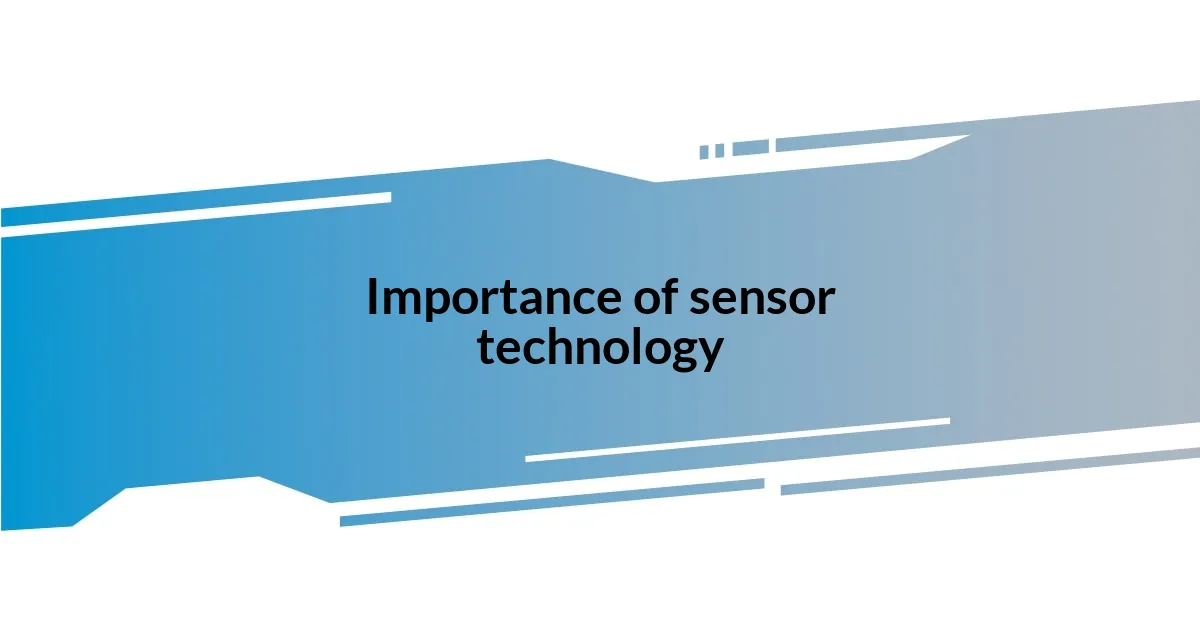
Importance of sensor technology
Sensor technology is at the heart of modern cameras, significantly influencing image quality and performance. I still remember the first time I experimented with a full-frame sensor. The light capture was astounding, allowing me to shoot beautifully detailed images even in challenging lighting conditions. It truly felt like I was seeing the world through a new lens!
Key points highlighting the importance of sensor technology include:
- Image Quality: Larger sensors capture more light, resulting in better clarity and detail.
- Dynamic Range: Advanced sensors can record a wider range of light and dark tones, enhancing the overall image.
- Low-Light Performance: Improved sensitivity allows for stunning shots in dim environments without excessive noise.
- Depth of Field Control: Different sensor sizes influence how much background blur you can achieve, enhancing creative expression.
- Speed and Performance: Sensor advancements lead to quicker readout speeds, crucial for continuous shooting in fast-paced situations.
Understanding these aspects has not only elevated my photography but also transformed how I perceive the world around me. Every image now tells a richer story, thanks to the technology that captures it.
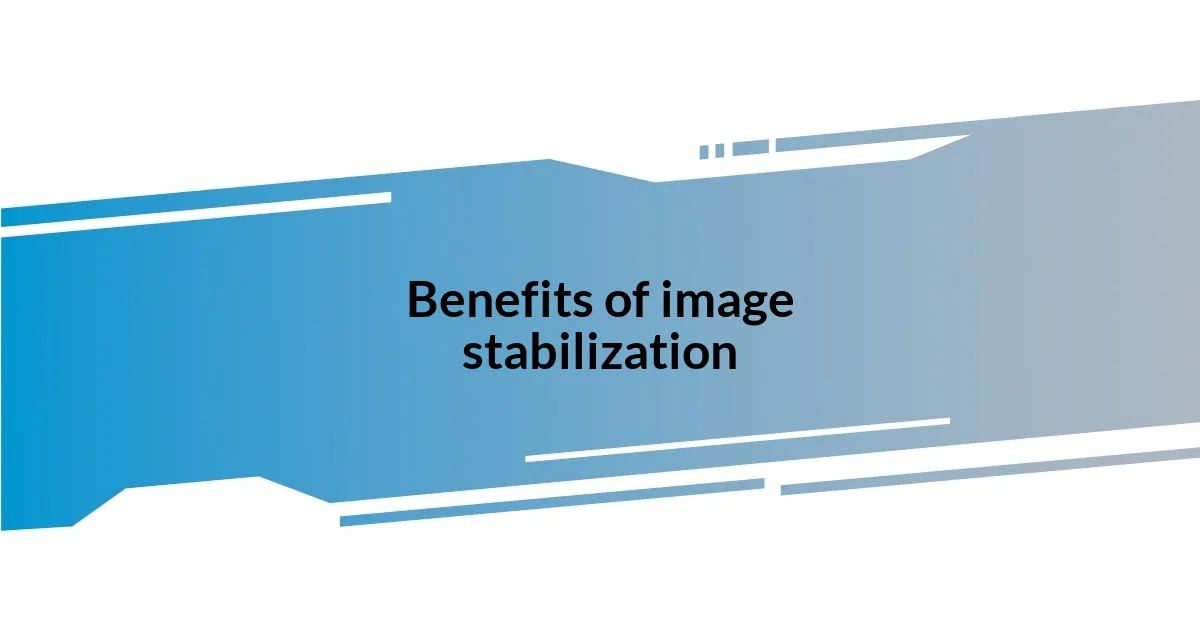
Benefits of image stabilization
One of the remarkable benefits of image stabilization is its ability to minimize blurriness in photos, especially when shooting handheld. I vividly recall a hiking trip where the landscape was breathtaking, but my shaky hands threatened to ruin the shots. Thanks to this feature, my images turned out surprisingly sharp even on the move—not a single one lost to the blur. What a relief that was!
When it comes to low light situations, image stabilization truly shines. I remember taking photos at a cozy evening gathering. Without stabilization, those moments might have slipped away in indistinct shadows. However, with this technology, even my slow shutter speeds yielded crisp clarity, freezing time with perfect precision.
Lastly, the confidence that comes with image stabilization cannot be overlooked. It empowers me to step into creative territories, capturing the action without fear of motion blur. I think of a recent street photography session where I wanted to snap candid moments of bustling life. With this feature, I felt free to zoom in and out, knowing I could trust my camera to yield solid results. Isn’t it exhilarating to explore photography without limitations?
| Feature | Advantage |
|---|---|
| Image Clarity | Minimizes blurriness in handheld shots |
| Low Light Performance | Maintains sharpness in dim environments |
| Creative Freedom | Empowers photographers to capture dynamic scenes confidently |
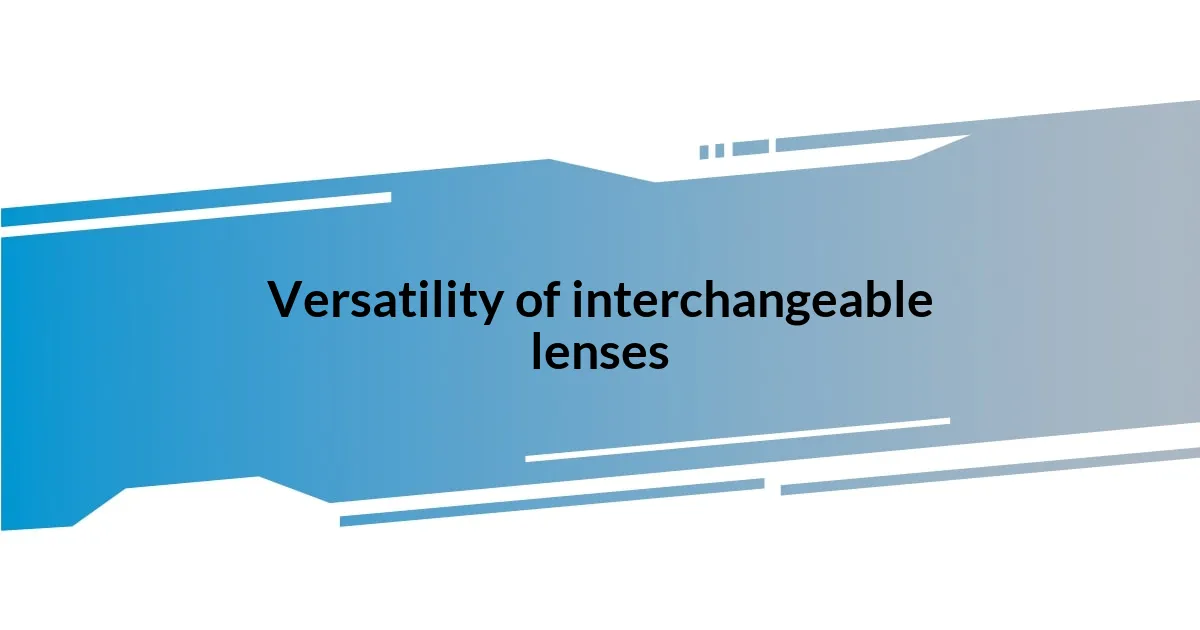
Versatility of interchangeable lenses
Interchangeable lenses are perhaps my favorite aspect of modern cameras, offering a spectrum of creative possibilities that can transform my photography experience. I remember walking through a vibrant market, where the colors and textures were utterly mesmerizing. Switching to a macro lens allowed me to capture intricate details of a flower vendor’s blooms, revealing patterns I had never noticed before. Isn’t it remarkable how a simple lens change can open up an entirely new world?
Having a versatile selection of lenses pushes me to think outside the box. On a recent trip to the beach, I was torn between capturing sweeping landscapes and the energetic bursts of children playing in the surf. Grabbing my wide-angle lens, I pulled off stunning seascapes that stretched far into the horizon, only to switch quickly to a telephoto lens for close-ups of joyful moments—frozen sprays of water and radiant smiles. This adaptability lets me respond spontaneously to my environment, turning every outing into a potential masterpiece.
The thrill of experimenting with different lenses feels like having an evolving toolkit at my disposal. Some days, I might want to capture sweeping landscapes that evoke grandeur, while other times, I yearn for portraiture that communicates intimacy and connection. Each choice affects the narrative of the photo. So, I often find myself reflecting on how different focal lengths can emphasize our visual stories, playing with depth and perspective. Isn’t it just exhilarating to play with light, angles, and moods through the magic of interchangeable lenses?
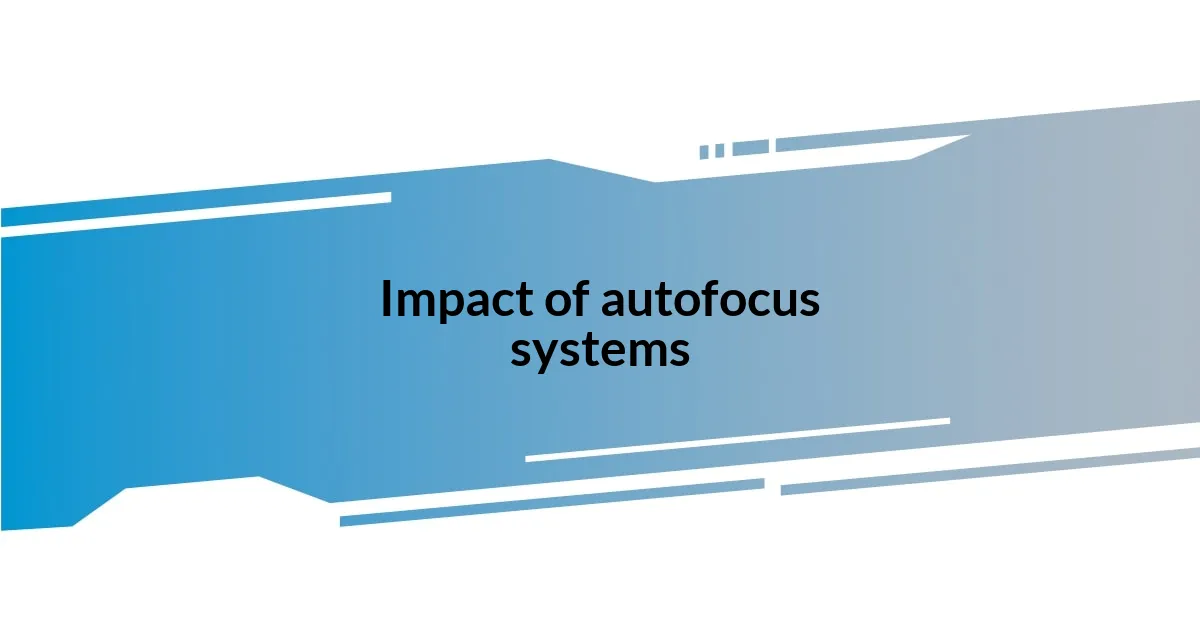
Impact of autofocus systems
The impact of autofocus systems on modern cameras can’t be overstated. I still remember the first time I used a camera with advanced autofocus – it felt like magic when my subject was tracked effortlessly. The system zeroed in on movement, allowing me to capture a friend’s laughter mid-jump at a family barbecue. In that moment, the clarity and focus brought my photo to life, immortalizing the joy we felt.
I find that the different modes of autofocus, like continuous and single-shot, greatly enhance my shooting experience. During a recent wildlife photography excursion, I utilized the continuous autofocus mode as I tried to capture a bird in flight. The camera kept pace with its quick movements, and my pictures turned out vibrant and sharp. This level of precision gives me the confidence to pursue even the most fleeting moments—who knew that capturing the perfect shot could feel so liberating?
Moreover, the ability of modern autofocus to distinguish between subjects is astonishing. I once participated in a street photography workshop where the instructor emphasized tracking genuine human emotion. My autofocus zone adjusted seamlessly as people moved through the bustling environment, allowing me to focus on the story unfolding before my eyes. Isn’t it incredible how technology can enable us to connect with our subjects on such a profound level?
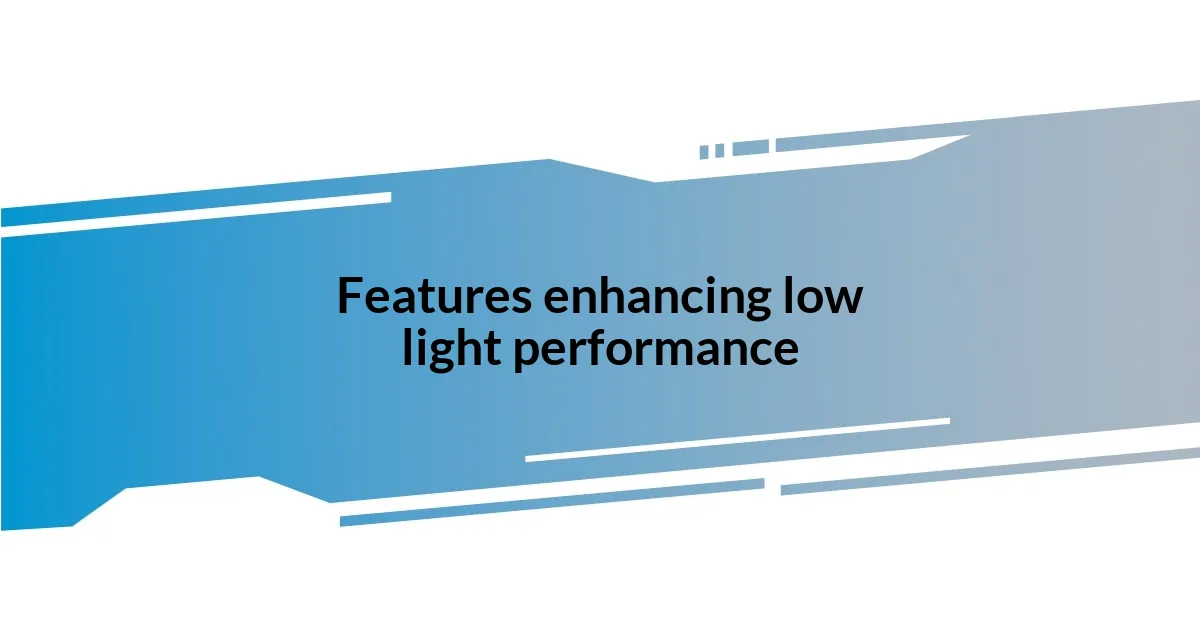
Features enhancing low light performance

Features enhancing low light performance
One of the standout features that elevates low light performance in modern cameras is the large sensor size. I recall shooting at an intimate concert, where the lighting was dim but the energy was electric. With a full-frame sensor, my camera captured rich, vibrant colors and minimized noise, allowing the atmosphere of the event to shine through beautifully. It’s fascinating how sensor size can dramatically transform the quality of images taken in challenging lighting conditions, isn’t it?
Additionally, I’ve grown fond of lens options with wide apertures, typically ranging from f/1.2 to f/2.8. I remember attending a cozy coffee shop gathering with friends, where the ambient light was minimal. Using my fast 50mm lens, I was able to focus on my friends’ expressions while creating a dreamy background blur. This ability to gather more light not only improved the exposure but added an artistic touch, capturing moments that might have faded into the shadows.
Let’s also not overlook the incredible advancements in image stabilization technology. Just last month, I ventured out for night photography, aiming to capture the city skyline against the starry sky. The in-body stabilization feature in my camera meant I could shoot at slower shutter speeds without the dreaded shake that can ruin a shot. Isn’t it magical how technology can allow us to take stunning long-exposure photos without a tripod? It makes me appreciate the artistry of photography even more, opening doors to creativity that were once limited by equipment constraints.
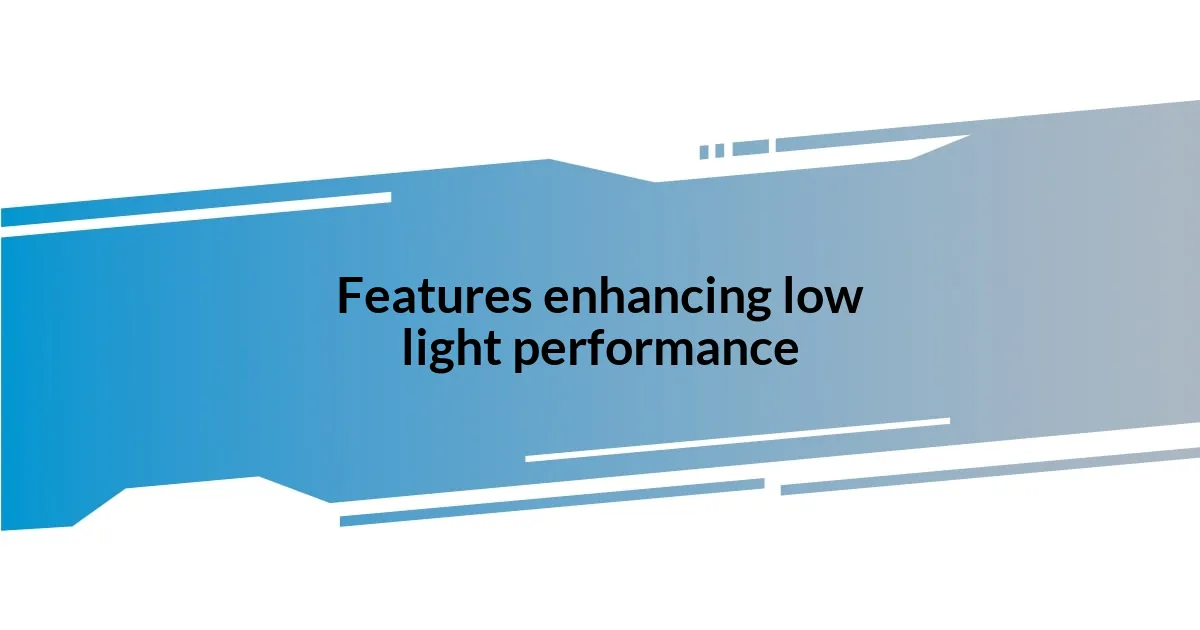
Creative modes for photography skills
Exploring creative modes in modern cameras truly expands the horizon of photographic possibilities. I remember my first experience with a creative mode—when I switched on the panorama setting while hiking through a breathtaking landscape. The result was a sweeping view of rolling hills and vibrant skies that simply couldn’t be captured in a single frame. Isn’t it inspiring how a simple feature can transform a scene and evoke emotion?
One mode that I find particularly exciting is the double exposure feature. During a portraits session, I played around with this setting, merging a close-up of my friend’s thoughtful expression with an artsy forest backdrop. The final image captured not just her beauty but also her love for nature, creating a story within a single photograph. I often wonder how many unique narratives can be crafted with such tools—what stories are just waiting to be told through transformative settings?
Another favorite of mine is the time-lapse mode, which allows me to condense hours of moments into a breathtaking few seconds. Once, I set up my camera during a sunset, capturing the vibrant shift of colors as daylight faded into night. Watching the final video play out, I was filled with awe; it felt like experiencing the very essence of time itself. Have you ever thought about how these creative modes inspire you to look at the world differently? It’s a reminder that photography is not just about capturing a moment, but about expressing creativity in ways we never thought possible.